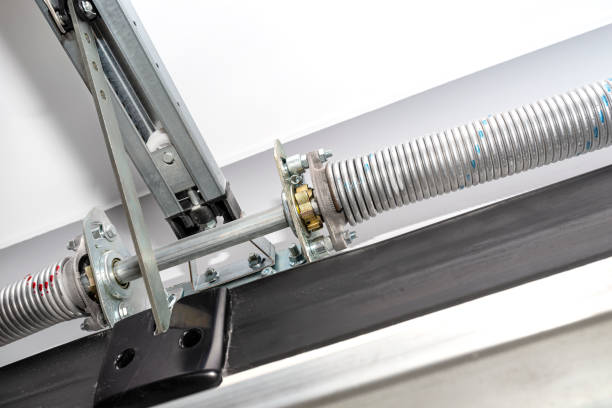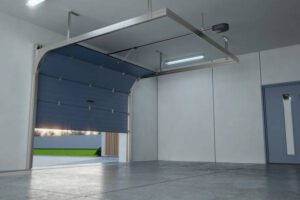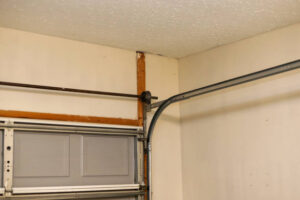Knowing how to tension a garage door torsion spring is important for keeping your garage door working safely and smoothly. The torsion spring carries most of the door’s weight, so if it’s not properly balanced, your door may feel heavy, close too fast, or stop working evenly. With the right tools, like a garage door torsion spring bar tool, and by following simple garage door torsion spring safety tips, you can safely adjust and maintain your spring system. Learning how to wind garage door springs safely improves door performance and helps you avoid costly garage door torsion spring repair later on.
What Is a Garage Door Torsion Spring & Why Tensioning Matter?
One of the most important components of your garage door system is the garage door torsion spring. It assists in opening and closing the heavy door. The spring is attached to the door by a metal shaft above the door and connected to the drums and cables at both ends. The spring coils and uncoils with the weight of the door when you close or open the door.
The Garage door spring winding direction is significant. It has one spring winding clockwise and another anticlockwise, thereby ensuring that the door moves freely. When you twist it in the wrong direction, the spring will not store the right amount of tension, which can lead to the door jerking or remaining in an uneven state.
When the spring is too loose, your door will feel heavy, not be able to stay open, or may even close too quickly. The spring should not be too tight because this will cause the door to lift itself or cause your opener to be overworked. Finding the right balance will be important to safe and smooth running.
Tools & Safety First: Garage Door Torsion Spring Safety Tips
Before you start adjusting or Garage door spring winding direction, safety should be your top priority. These springs are under a lot of pressure and can cause injury if not handled correctly.
You’ll need these tools:
- Garage door torsion spring bar tool (winding bars)
- Adjustable wrench or socket wrench
- Sturdy ladder
- Safety gloves and eye protection
Follow these safety rules:
- Disconnect the garage door opener, then start.
- Fix the door to the track to prevent movement.
- Never apply screwdrivers or random rods; always use two winding bars.
- Adjust in such a way that your body and face are not facing the spring.
Always be careful not to make any changes to a torsion spring in case of uncertainty or a lack of proper tools. When you feel that you are uncomfortable doing something, it is best to call a professional.
How to Wind a Garage Door Torsion Spring Safely?
After making precautions, it is time to wind up the spring. These steps must be taken one at a time and checked step by step.
Step-by-step guide:
Open the door all the way and firmly fasten it on the tracks with clamps.
Insert winding bars in the holes of the winding cones.
Spin the bars in the proper direction, clockwise or anti-clockwise, again depending on the location of your spring. (The number of turns required per door depends on height, and this is referred to as the garage door torsion spring turns count.
Wind the set screws and tighten them.
Take off the clamps and check the balance – half open a door and check whether it does not fall.
In case the door shifts upwards or downwards automatically, make some adjustments. The right tension is when the door is light, moves about, and is at equilibrium in any position.
It is a patient exercise to have it right, but when done correctly, your garage door will open and close easily. When you are in doubt, just do not take a chance and call a garage door torsion spring repair specialist to do the job safely.
Adjusting Torsion Spring After Installation & Maintenance
When you have installed a new torsion spring, you might find that your garage door is unbalanced or heavy. This normally implies that the tension is not fixed at the point. To correct this, modify the spring tension slightly. When the door closes too quickly, it should be tightened a little more. When it increases on its own, it is too strained and requires relaxing. Turn a quarter at a time–always–test after turning.
Garage door spring maintenance will ensure the system is safe and smooth. Coat the spring with a light garage door spray oil after every few months to minimise friction. Check the cable drums and lift cables for rust or frayed. Tighten loose bolts and ensure door tracks are free.
Calibrate of garage door springs, set the door to half, and release it. In case it does not move, then that spring is correctly balanced. In case it goes up and down, slightly adjust it to make it stay. Appropriate calibration to make your door run silently and last even longer.
Common Torsion Spring Tension Troubleshooting & Fixes
Even minor problems with spring tension can result in major problems at times. The most typical symptoms to consider are these:
The garage door is not opening at the same rate: One side of the spring system might be tighter than the other.
Closing of garage doors too quickly: The springs are not strong enough to support the weight.
The door of the garage is heavy to open: The spring is loose or is old.
Unequal tension on garage doors: Test the springs and cables to see if they are in the correct place. Stiffen or change the weaker side where necessary.
Wrong tension may lead to the problem of strain in garage door openers as well. The motor exerts a greater load than usual, causing premature wear or failure. Prevent expensive repairs by repairing tension problems at the earliest stage and maintaining your door in balance.
In case you are in doubt or the door does not move easily after you make some adjustments, then you had better call a garage door torsion spring repair specialist. These can quantify spring torque and balance it to precision with professional equipment.
When Repair Isn’t Enough: Garage Door Torsion Spring Repair & Replacement?
The spring is sometimes too old or worn out to cause tension. Then the only option is to install a complete replacement of the garage door torsion springs. Symptoms that indicate the necessity of replacement are the noticeable distance between the spring coils, rust, loud clicking sounds, or the inability to raise the door entirely.
An effective repair or replacement involves the removal of old springs, installation of new springs, re-tensioning, and balancing the cables. The price is based on the size of the door, the number of springs, and the labor rates in the area, but in most cases, it is much less than the cost of a complete door replacement.
Although it might save a few dollars, the torsion springs are dangerous to work with. A single misstep may lead to injury or damage to property. Enlisting professional help would help in ensuring that your system is adjusted safely, tested appropriately, and prepared to perform long-term.
Conclusion
Now that you understand how to tension a garage door torsion spring, you can check for signs like the garage door not opening evenly or the garage door feels heavy to lift and fix them before they become serious. Regular garage door spring maintenance and proper garage door spring calibration will keep your door balanced and prevent garage door opener strain issues. If your garage door spring is too tight or too loose, or the damage is beyond adjustment, it’s best to ask a professional for help and get an estimate on garage door torsion spring replacement cost. A well-tensioned spring means a smooth, quiet, and reliable garage door daily.
FAQs
Why is my garage door not opening evenly or closing too fast?
If your garage door is not opening evenly, one torsion spring may have more tension than the other. When that happens, the door becomes unbalanced and tilts to one side. A garage door closes too fast means the springs don’t have enough tension to support the door’s weight. Adjusting the springs evenly or calling a professional for a garage door torsion spring repair will usually fix the issue.
My garage door feels heavy to lift or won’t stay open — what does that mean?
When your garage door feels heavy to lift or won’t stay open, it’s a sign that the garage door spring is too loose or worn out. Try adding a little more tension, but if the problem continues, it might be time to check the garage door torsion spring replacement cost and get new springs installed for safety.
How to fix unbalanced garage door?
If your door looks crooked or shakes when moving, you likely have uneven garage door tension. This can happen from regular wear or incorrect spring adjustment. The best uneven garage door tension fix is to re-tension both springs evenly and check cable alignment. Always perform this carefully, or contact a technician if you’re unsure how to fix an unbalanced garage door safely.
What are the symptoms of incorrect spring tension, and how does it affect the opener?
Symptoms of incorrect spring tension include jerky movement, loud noises, or the door not staying in place. When the garage door spring is too tight or too loose, it can also cause a garage door opener strain issue — making the motor work harder and possibly burn out early. Properly adjusting or replacing the springs helps the opener run smoothly and extends the life of the whole system.






